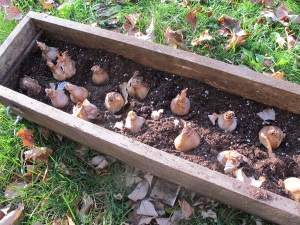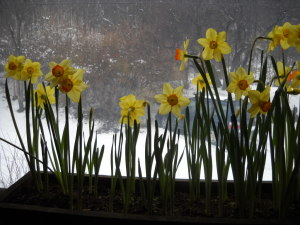Forcing Bulbs
I love to ski and snowshoe. I don’t mind shoveling snow and lugging in firewood for the woodstove the chugs along day and night now. But there are limits to my patience, and by March I’ll ready for green growing things and some fresh flowers. So I start lots of veggies and flowers by seed, starting in March and April. But I also force bulbs to bloom indoors in March. Now is the time to do so.
Most bulbs are described on their packages as early, mid-season or late. Go to your local garden center and ask for bulbs that are early bloomers because they are the best for forcing. Buy daffodils, some tulips and maybe some small bulbs like crocus or snowdrops. You can plant these bulbs in large pots or even in your window box that is, by now, cleaned out and stored in the garage or barn.
You will also need some potting soil and compost. I make a mix that is half compost, half potting soil for forcing bulbs. I don’t use garden soil because it can be heavy and often stays wet. Bulbs can rot if they are left in wet soil for too long.
I recently planted 25 daffodils in a window box that is about 30 inches long, 6 inches wide and deep. It was a mix of different kinds of daffodils. I prefer to get all of one kind so that they all bloom at once, but the mixed bag was what was available (and on sale).
I filled the window box a little more than half full with my mixture of compost and potting soil and placed the bulbs, pointy end up, in the soil. Once I had them all in place I pushed them down more and filled up the box with more potting soil-compost mixture. Bulbs for forcing can be planted shoulder to shoulder, or nearly so.
In order to prepare bulbs for early blooming indoors, you will need a place to store them that is cold, but not as cold as the outdoors. Despite global warming, I still see minus 20 every winter, even if for only a few days. Bulbs planted in the ground have some protection against the cold, but if you were to plant bulbs in pots and leave them outside, the extreme temperatures would kill most. Bulbs left in a cool basement or garage will do just fine. Inside the bulkhead to your cellar might be the right temperature, too.
Ideally temperatures for bulbs used for forcing will be between 25 and 50 degrees, though colder temperatures should not be a problem (my basement often goes below freezing). Left in a warm location, the bulbs will grow green tops – but not blossoms.
You need to be aware that rodents like eating bulbs (indoors or out) – especially tulips. My basement has, most years, harbored mice and even sometimes red squirrels. In fact, I have learned the hard way that indoor rodents can – and will – dig up and eat tulips. So now I keep my pots of tulips covered with hardware cloth (a fine-mesh metal screening available at hardware stores). But wear gloves if you cut hardware cloth to size – the edges are as sharp as razor wire. Daffodils, on the other hand are not of interest to rodents as they are mildly poisonous.
You can double your production of blooms by planting two layers of bulbs in a container. Plant big bulbs deep in the pots, add soil, and then plant a layer of crocus or other small bulbs above them. To avoid planting the little guys right over the big boys, you can mark the location of the deeper bulbs with straw from a broom. That way they won’t get pushed over as the daffodils come up. Or you can just take your chances.
Don’t wait until mid-December to start your bulbs, get on this project now. Daffodils take about 12 weeks of dormancy before they should be brought into the warmth of the house, and tulips do better with 4 full months. Planted now, they would be ready in mid-March. Little things like crocus can be forced in 8 to 10 weeks.
It is important to check on the bulbs you are forcing at least once a month, particularly if you have put wire rodent-proofing over the containers. I’ve had shoots get damaged by trying to grow through the hardware cloth. If the bulbs are sending up shoots, remove the wire mesh. I also don’t want the soil mix to get bone dry, so I check it and water a little if it is too dry. The bulbs will grow roots when first planted, and then go dormant if kept in a dark, cold location.
When it is time to bring up your potted bulbs into a warm place, let them wake up gently. My mudroom is good for starting them: there is some sunshine but it is cool. Then, once the shoots are up and green, I place the containers on my sunniest window sills – either east or west facing.
I was a Peace Corps volunteer in Cameroon, West Africa many years ago. There I could have flowers blooming outside every day of the year. It spoiled me, perhaps, because I still want flowers every day. Forcing bulbs is one way to have lots of blossoms when there is still snow on the ground.
Henry Homeyer is the author of 4 gardening books. His Web site is www.Gardening-Guy.com. You may also reach him by e-mail at henry.homeyer@comcast.net.




